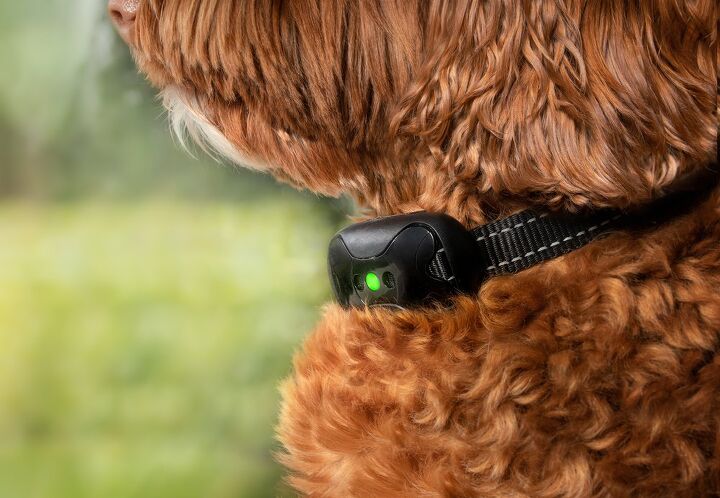Can Shock Collars Damage a Dog’s Vocal Cords?

With so many pet owners now working from home and trying to focus on reading reports, creating presentations and conducting professional-quality meetings via Zoom, that incessant barking from Rover may well have begun to deep-six your productivity levels. Am I right?
You may even be thinking that a shock collar might be the quickest way to train your pooch that barking at the neighbor, the cat, or a leaf blowing by the back door, is no longer acceptable. But you would be wrong.
Let’s start by saying that no reputable dog trainer uses a shock collar to modify the behavior of a house pet. The only caveat to this rule might be hunting or guard dogs, where imminent danger often requires a quick signal to the animal to heed a command. That said, punishment-based training – which is what the pain from a shock collar delivers – can damage both the bond between you and your pet as well as his self-confidence. It’s discouraged by the Canadian Veterinary Medical Association and humane societies throughout North America.
How Does a Shock Collar Work?
Also known as training collars, e-collars and remote training collars, the shock collar looks similar to a regular dog collar but has two thick metal prongs that rest up against your pet’s vocal cords. When he barks, the vibration causes an electrical current to pass through these contact points. The level of current can be modified remotely by the owner and typically ranges from a milder tingling effect to a full-blown, painful shock. Because you don’t know what your dog’s tolerance to pain will be, this can become a dangerous exercise in trial and error. And that’s why only professional trainers working with large breed guard dogs should be at the controls.
And be aware that while the shock itself may be temporary the fear and psychological damage caused to your pet can be long-lasting. Because dogs may not immediately connect the dots, he isn’t going to understand what he did to cause this painful outcome. As a result, he may become fearful and cautious, losing the confidence needed to develop into a happy, secure pooch.
Can Shock Collars Damage Vocal Cords?
The short answer is yes, with continued use a shock delivered from this type of collar can damage your pet’s throat, and vocal cords and under certain conditions, cause electrical burns if the unit malfunctions. These injuries can happen if the fit is too tight or the electric current used, is too strong for the size of the dog. And for smaller dogs or animals with health issues, the high levels of stress caused by wearing a shock collar and the resultant increased heart rate that comes from painful shocks can be lethal.
Alternative Solutions:
So, we agree that a shock collar isn’t the right way to bring a sense of calm to your home workspace. But that still begs the question of what to do with a yappy dog and those workload deadlines.
Before you can teach your dog to “curb his enthusiasm” you need to understand what’s causing his need to continually speak up. As recommended by the American Society for the Prevention of Cruelty to Animals (ASPCA), a few questions you could try asking yourself are these:
1. Where does the barking typically occur? Front door? Window? Outside your closed office door? Back door leading to the garden?
2. When does the barking happen? Around a meal period? When he typically goes for his walk? After eating when he may need to go out?
3. Who or what is the target of the barking? Has another dog just walked by? Is Amazon delivering a package? Is he peckish and barking at the treat jar?
You’re looking for both random drivers such as the doorbell ringing unexpectedly to routines that may have been broken – like forgetting to let him out for a comfort break after he’s eaten his morning meal.
If you’ve noticed a pattern, congratulations. You may well be on your way to modifying his behavior when these situations present. And while there are several online training sessions worth checking out, we’re sharing some recommendations from the guru of all things “dog”, the American Kennel Club (AKC).
Cause: He Can’t See You
Who’s that barking and scratching at your door? He knows you’re in there and is determined to reach you. I’ve had both cats and dogs scratching at my door during an important Zoom call, so I know the frustration. What AKC suggests is that you leave the radio, TV, iPad or other device turned on and play music or a Netflix classic in a separate living space. The idea is that these sounds approximate the noises your pet hears when you’re there with him. He doesn’t feel quite so isolated and with a little background noise, may not hear those pesky outside noises either. Tip: Spotify and other streaming services offer Music for Dogs that are designed to soothe.
Cause: Boredom
Ho-hum. Are you done yet? If your dog’s impatience is causing him to bark to get you up and to interact with him, it’s time to break out the toys. And puzzles. And interactive videos. Bury some treats in a Kong, hide some high-value treats in a puzzle board, or get him one of those flavored nylon bones that seem to last forever. The trick is to give him something else to do. A snuffle mat where he has to root around for pieces of dry kibble can also act as a feeding mat to keep him busy, longer.
Cause: Too Much Energy
This is a likely cause for barking with dogs whose pet parents work from home and tend to forget about those morning walks that help to burn off energy. Don’t underestimate how well-behaved (and quiet) a pooped pup can be when you’re trying to get work done. And if timing is tight but the budget isn’t, consider hiring a dog walker to pick up your pooch at a set time each day. They get a workout and you get at least one full hour of total peace.
Cause: You Always Respond
The solution is right there in the cause. You always react to your pet’s barking and that’s what he’s looking for. Whether you’re turning to him and telling him to settle down, are putting him outside for a little “you” time, or are handing him a bone and asking him to go to his crate or bed… he’s getting what he wanted - you. Solution? Don’t respond. When he finally quiets down, reward him with a treat. But only after he’s been laying quietly and not barking for a few minutes. And yes, ignoring his yapping while you’re trying to get some work done, is going to be a challenge.
Cause: You’ve Not Asked Him to Stop
One of the more popular methods of training your pooch to think twice about barking s called “Quiet” training. When your dog begins to bark – regardless of whether it’s an unexpected trigger or he simply wants your attention – say “quiet” in a calm yet firm voice. When he stops, call him away from the source (window, door, another animal) and ask him to sit. Upon him obeying this command, provide him with his treat as a reward. In some instances, you may want to gently hold his muzzle to get his attention, then issue the command.
The above training tips are effective alternatives to shock collars. They’ll help build a bond between you and your pet along with a tacit understanding of what you expect from him. And in the end, help bring a little peace and quiet to your working world.

Sharing space with three seriously judgy Schnoodles and a feline who prefers to be left alone. #LivingMyBestLife
More by Mary Simpson























